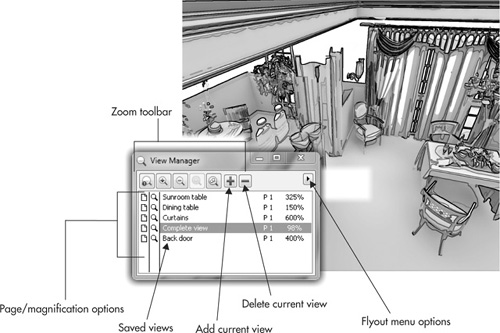Imagine a bookmark feature in CorelDRAW that
takes you to a location and viewing resolution on one or more pages
just by clicking the link. This is what the View Manager does: you can
define zoom levels and page locations, you can browse to any number of
pages in the same document, and your document is not only better
organized for future edits, but View Manager is a darned good
presentation tool as well!
To open the View Manager, choose Window | Dockers | View Manager or press CTRL+F2. Figure 1
shows a practical use for the View Manager: here you can see an
architectural drawing. All the different parts of the room have been
“viewed,” and different pans and zooms have been defined for the
sunroom, the dining room, and so on. Now the illustrator or client can
click around the structure to get a comprehensive virtual tour of the
proposed design. The View Manager is also useful for tagging and
returning to an exact point in a drawing where you might need to take a
break! If you have a multi-page document, View Manager can accommodate
your need to pinpoint any view on any page.

Exploring View Manager Commands
When
a view is saved, its page number, position, and view magnification are
recorded and become a new view in the View Manager docker window.
This sort of feature calls for a hands-on review,
tutorial style. There are no “right” or “wrong” steps—this is just an
exploration by-the-numbers!
Making and Taking a Structured View of a Document
Open
an existing document containing a drawing, either completed or in
progress, and the more complex the better, and then open the View
Manager docker window (CTRL+F2).
Using
page navigation commands and the Zoom tool, the Zoom command buttons on
the Zoom property bar, and/or the View Navigator feature, go to a
specific part of your drawing in the document window.
To
create and save your current view, click the Add Current View button in
the docker. Notice that a new item appears in the View Manager docker.
By default, the new view is automatically named View-nn-nnnn%;
the first numbers after “View” represent a sequence in which you save
views, while the last digits before the percent symbol tell you the
magnification level of the saved view. At the right on the docker is the
page number for the saved view and the zoom percentage again. The zoom
percentage is an important label at the right of each saved zoom and
cannot be edited. However, you’ll definitely want to replace the first
zoom percentage with an evocative name for the zoom—this first zoom
percentage field is just a default name for the saved zoom.
To
name the view, right-click the name, choose Rename from the pop-up
menu, and then type a name to enter the new view name. Your view is now
saved. If you want, save more new views using the same procedure; change
the view display in your document window each time, and then click the
Add Current View button each time to save each view.
To
go to a view, click either the page number or the view magnification
title of the saved view on the docker’s list. Your view is then changed
to the exact point at which it was saved.
To
delete a specific view in the View Manager docker, click to select the
view, and then click the Delete Current View button. The view is
immediately deleted.
Tip
In
addition to the interactive methods you can use to save, name, recall,
and delete saved views, the same operations can be accomplished by
choosing commands on the flyout menu located on the View Manager’s
docker window.
Using Page and Zoom Options
To the left of each saved view in the View Manager,
two options will appear. These options give you control over how your
saved views are recalled and restored. For each view saved, you can
toggle display of the Page Only and the Magnification Only to On or Off.
Single-clicks toggle these options on and off; grayed-out options
indicate an inactive state.
When the page symbol is deactivated,
recalling the corresponding saved view causes only the magnification to
be recalled; when the zoom symbol is deactivated, only the page display
is recalled. While both are deactivated, the saved view does absolutely
nothing.